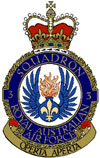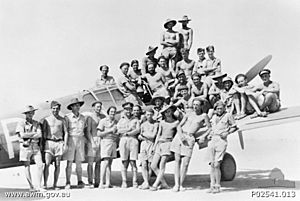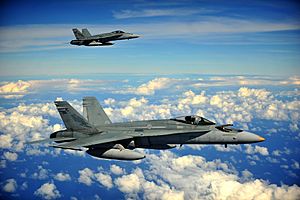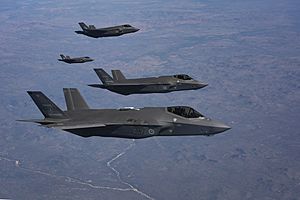No. 3 Squadron RAAF facts for kids
Quick facts for kids No. 3 Squadron RAAF |
|
|---|---|

No. 3 Squadron's crest
|
|
| Active | 1916–1919 1925–1946 1948–1953 1956–current |
| Country | Australia |
| Branch | Royal Australian Air Force |
| Role | Multi-role fighter |
| Part of | No. 81 Wing, Air Combat Group |
| Garrison/HQ | RAAF Base Williamtown |
| Motto(s) | Operta Aperta ("Secrets Revealed") |
| Engagements | World War I
World War II Cold War Military intervention against ISIL |
| Commanders | |
| Notable commanders | David Blake (1916–1918) Bill Anderson (1918–1919) Henry Wrigley (1919) Frank Lukis (1925–1930) Harry Cobby (1930–1931) Bill Bostock (1931–1936) Allan Walters (1938–1939) Ian McLachlan (1939–1941) Peter Jeffrey (1941) Alan Rawlinson (1941) Bobby Gibbes (1942–1943) Brian Eaton (1943–1944) Vance Drummond (1967) Jake Newham (1967–1968) Richard Bomball (1973–1974) Geoff Brown (1997–2000) |
| Aircraft flown | |
| Fighter | F-35A Lightning II |
No. 3 Squadron is a special fighter squadron in the Royal Australian Air Force (RAAF). It is based at RAAF Base Williamtown, which is near Newcastle, New South Wales.
This squadron was first created in 1916. It was one of four combat squadrons in the Australian Flying Corps during World War I. They flew missions on the Western Front in France. After the war, the squadron was temporarily closed in 1919.
No. 3 Squadron started up again as a permanent RAAF squadron in 1925. During World War II, they fought in the Mediterranean region. In the years of the Cold War, the squadron was closed and reopened twice. It was based in Malaysia during the Malayan Emergency and the Indonesia–Malaysia Konfrontasi.
From 1986, the squadron used McDonnell Douglas F/A-18 Hornet fighter jets. In 2002, they went to Diego Garcia to help protect the air. The next year, they sent planes and crews to the Iraq War as part of Operation Falconer. In April 2016, they went to the Middle East to join the military intervention against ISIL. Since 2018, the squadron has been getting new Lockheed Martin F-35 Lightning II fighter jets.
Contents
History of No. 3 Squadron
World War I Missions
No. 3 Squadron was formed on 19 September 1916, at Point Cook, Victoria. Major David Blake was in charge. It was one of the first four combat squadrons of the Australian Flying Corps. The people in the squadron were part of the Australian Army.
Soon after, the unit traveled by ship to England for training. In September 1917, they became the first Australian Flying Corps squadron sent to France. They flew R.E.8 aircraft, which were two-seat planes used for reconnaissance (finding out information) and general tasks. To avoid confusion with a British squadron, the British military called them "No. 69 Squadron RFC." However, the Australians always used their own name, and the British name was dropped in 1918.
After moving to the Western Front, the squadron was first based at Savy. In November 1917, they were given the job of a corps reconnaissance squadron. This meant they supported the I Anzac Corps near Messines. They set up their base at Bailleul. No. 3 Squadron stayed with I Anzac for the rest of the war. They flew missions to drop bombs, help artillery aim, and gather information. These missions supported Australian and other British Empire ground forces.
Their first air-to-air victory (shooting down an enemy plane) happened on 6 December 1917. By the end of the war, their pilots had shot down 15 German aircraft. They also flew a total of 10,000 hours on missions.
In early 1918, Germany launched a major attack on the Western Front. As the Allies were pushed back, the squadron's airfield at Baileul was too close to German guns. They moved to Abeele and then to Poulainville. During this attack, the squadron mostly worked in the Somme Valley. They helped artillery spot targets.
In April 1918, the squadron was involved with the remains of the famous German pilot, the "Red Baron," Manfred von Richthofen. He was shot down in their area. Major Blake first thought one of his squadron's planes might have shot him down. But later, he agreed that an Australian anti-aircraft machine gunner likely shot down the Red Baron.
In July, the squadron flew reconnaissance missions to support the Australian attack at Hamel. Later, in August, they joined the final Allied attack of the war near Amiens. They flew support missions until the war ended in November. Just before the war ended, the squadron started to switch to Bristol F.2 Fighter planes.
After the war, the squadron briefly delivered mail. They returned to the United Kingdom in early 1919. The squadron was officially closed in February, and its members went back to Australia over the next few months. During the war, 32 squadron members were killed and 23 were wounded. Most of these were aircrew. The squadron lost 11 aircraft during the war.
Between the World Wars (1925–1939)
In 1925, No. 3 Squadron was started again. It became part of the new and independent Royal Australian Air Force. Squadron Leader Frank Lukis was in command. The squadron was first based at Point Cook and then at Richmond. They flew many different types of aircraft. These included S.E.5As, DH.9s, Westland Wapitis, and Hawker Demons.
World War II Missions
When World War II began, No. 3 Squadron was one of 12 permanent RAAF squadrons. Its first job was to work with the army. In mid-1940, it was sent to the Middle East to support the 6th Division of the Australian Army. The squadron stayed in the Mediterranean area for the entire war. They became part of the Allies' Desert Air Force. This force supported the 8th Army.
Squadron Leader Ian McLachlan was in charge. The squadron members traveled by sea to Egypt. There, they received aircraft from British Royal Air Force (RAF) supplies. At first, they used older biplane aircraft like the Gloster Gauntlet and Gloster Gladiator for close air support. They also used the Westland Lysander for reconnaissance against Italian forces in Egypt and Libya. During these missions, the squadron fought against planes from the Regia Aeronautica (Italian Air Force).
They then briefly used the Hawker Hurricane. In 1941, they switched to the Curtiss P-40B/C Tomahawk. They saw action against Vichy French aircraft during the Syria–Lebanon campaign.
With the Tomahawk and its newer version, the Kittyhawk (P-40D to P-40N), the squadron returned to the North African campaign. They often had intense air battles with advanced fighters. These included the Italian Macchi C.202 and the German Luftwaffe Messerschmitt Bf 109E/F from 1941 to 1943. There is a story that No. 3 Squadron attacked German ground forces in Tunisia on 3 April 1943. During this attack, Claus Von Stauffenberg was severely injured. He later tried to assassinate Adolf Hitler in 1944.

The longest-serving commanding officer (CO) of No. 3 Squadron during the war was Squadron Leader Bobby Gibbes. He was in charge from February 1942 to April 1943. Squadron Leader Brian Eaton took over from Gibbes and led the unit until February 1944. During this time, No. 3 Squadron took part in the Allied invasions of Sicily and Italy. In November 1944, they switched to P-51 Mustang planes. They continued to operate in Italy and Yugoslavia until the war in Europe ended in May 1945. No. 3 Squadron flew 25,663 hours on missions and destroyed 217.5 enemy aircraft. This made them the highest-scoring RAAF fighter squadron.
Cold War Era
After World War II, No. 3 Squadron returned to Australia. It was closed at Point Cook on 30 July 1946. It was started again at RAAF Base Fairbairn in Canberra in early 1948. At that time, No. 4 Squadron RAAF was renamed No. 3 Squadron. They used Mustangs, CAC Wirraways, and Austers. The squadron briefly worked as a reconnaissance and close support squadron before closing again in 1953.
The squadron started up once more on 1 March 1956, at RAAF Base Williamtown, New South Wales. From 1958, they flew CA-27 Sabres from Butterworth, Malaya. They took part in military operations during the Malayan Emergency and the Konfrontasi.
As Australia became more involved in the Vietnam War, No. 3 Squadron returned to Australia. In 1967, they got new Mirage IIIO fighters at Williamtown. The commanding officer, Wing Commander Vance Drummond, died during air combat training in May. Wing Commander Jake Newham (who later became Chief of the Air Staff) took his place. After training for air-to-air and air-to-ground missions, the squadron went to RAAF Butterworth in Malaysia in February 1969. Parts of the squadron also went to RAF Tengah and Paya Lebar Air Base. During this time, their planes were called "lizards." This was because of their camouflage paint and how they flew low. The frill neck lizard became an unofficial symbol for the squadron.
After 15 years in Malaysia, No. 3 Squadron came back to Australia. They gave their planes and many people to No. 79 Squadron. On 29 August 1986, No. 3 Squadron became the first RAAF unit to receive F/A-18 Hornet fighter jets.
After the Cold War
The squadron continued to fly Hornets from their home base at RAAF Base Williamtown. In February 2002, during the Afghanistan War, some members of No. 3 Squadron went to Diego Garcia in the Indian Ocean. They took over from No. 77 Squadron to provide air defense for the Coalition base there. No. 3 Squadron members also took part in Operation Falconer. This was No. 75 Squadron's mission during the Iraq War in 2003. They flew missions to stop enemy aircraft and patrol the skies.
The squadron is now part of the Air Combat Group's No. 81 Wing RAAF. In April 2016, No. 3 Squadron went to the Middle East for Operation Okra. This was part of the military intervention against ISIL. They took over from No. 77 Squadron.
On 8 December 2017, No. 3 Squadron stopped flying F/A-18s. The squadron was officially closed on 14 December 2017, under Wing Commander John Haly. It was then started again at Luke Air Force Base in Arizona, led by Wing Commander Darren Clare. All of its Hornets and most of its people moved to No. 77 Squadron. In February 2018, No. 3 Squadron had two Lockheed Martin F-35 Lightning IIs. They were planned to have ten by the end of that year. Two of these F-35s were planned to go to Australia in late 2018. The other eight stayed in the United States for training.
Aircraft Used by No. 3 Squadron
No. 3 Squadron has flown these aircraft:
- Royal Aircraft Factory R.E.8 (1917–1918)
- Gloster Gauntlet, Gloster Gladiator, Westland Lysander (August 1940 – January 1941)
- Hawker Hurricane (January–May 1941)
- P-40 Tomahawk/Kittyhawk (May 1941 – November 1944)
- P-51D Mustang (November 1944 – July 1946)
- CAC Sabre (1956–1967)
- Mirage III (1967–1986)
- F/A-18 Hornet (August 1986 – December 2017)
- F-35A Lightning II (2018 – current)
See also
- McDonnell Douglas F/A-18 Hornet in Australian service





